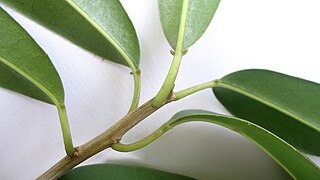
Sapium is a genus of flowering plants in the family Euphorbiaceae. It is widespread across most of Latin America and the West Indies. Many Old World species were formerly included in the genus, but recent authors have redistributed all the Old World species into other genera.

Amanoa is a genus from the family Phyllanthaceae first described as a genus in 1775. It is native to South America, Central America, the West Indies, and tropical Africa.

Phyllanthaceae is a family of flowering plants in the eudicot order Malpighiales. It is most closely related to the family Picrodendraceae.
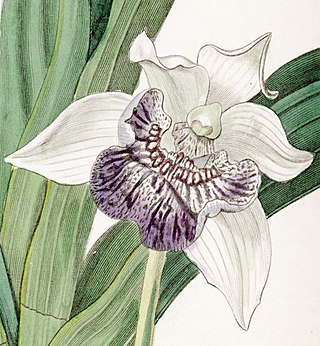
The genus Cochleanthes is made up of 4 species of orchids native to Mexico, Central America, the West Indies and South America. The name Cochleanthes refers to the shape of the flower.

Pera is a genus of plants in the family Peraceae native to tropical America, from southern Mexico and the West Indies south as far as Paraguay. It first described as a genus in 1784.
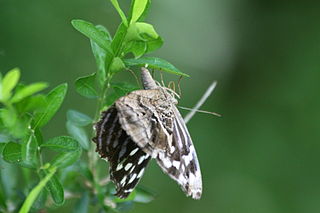
Adelia is a genus of flowering plants in the spurge family, Euphorbiaceae, subfamily Acalyphoideae. It is native to Latin America and the Caribbean, with one species extending northward into the southernmost part of Texas.
Lasiocroton is a plant genus of the family Euphorbiaceae first described as a genus in 1859. The genus is endemic to the West Indies. It is a member of the Leucocroton alliance, which also includes Leucocroton and Garciadelia. Species in this alliance are dioecious.
- Lasiocroton bahamensisPax & K.Hoffm. - Bahamas, Cuba, Haiti
- Lasiocroton fawcettiiUrb. - Jamaica
- Lasiocroton gracilisBritton & P.Wilson - SE Cuba
- Lasiocroton gutierreziiJestrow - Cuba
- Lasiocroton harrisiiBritton - Jamaica
- Lasiocroton macrophyllus(Sw.) Griseb. - Jamaica
- Lasiocroton microphyllus(A.Rich.) Jestrow - Cuba
- moved to other genera (Bernardia Croton Leucocroton)
- Lasiocroton cordifoliusBritton & P.Wilson - Leucocroton cordifolius (Britton & P.Wilson) Alain
- Lasiocroton prunifoliusGriseb. - Croton punctatusJacq.
- Lasiocroton subpeltatusUrb. - Leucocroton subpeltatus(Urb.) Alain
- Lasiocroton trelawniensisC.D.Adams - Bernardia trelawniensis(C.D.Adams) Jestrow & Proctor
Bernardia is a plant genus of the family Euphorbiaceae first described for modern science as a genus in 1754. It is native to North and South America, as well as the West Indies.

Chaetocarpus is a plant genus of the family Peraceae, formerly Euphorbiaceae, first described as a genus in 1854. Chaetocarpus species are trees or shrubs. They are native to the Americas, Africa, and Asia. Some species are endangered.
- Chaetocarpus acutifolius(Britton & P.Wilson) Borhidi – Sierra de Moa in Cuba
- Chaetocarpus africanusPax – C Africa
- Chaetocarpus castanocarpus(Roxb.) Thwaites – SE Asia, Yunnan, Assam, Bangladesh, Sri Lanka
- Chaetocarpus cordifolius(Urb.) Borhidi – Cuba, Hispaniola, Jamaica
- Chaetocarpus coriaceusThwaites – Sri Lanka
- Chaetocarpus cubensisFawc. & Rendle – Cuba
- Chaetocarpus echinocarpus (Baill.) Ducke – Bolivia, Brazil
- Chaetocarpus ferrugineusPhilcox – Sri Lanka
- Chaetocarpus gabonensisBreteler – Gabon
- Chaetocarpus globosus(Sw.) Fawc. & Rendle – Jamaica, Cuba, Dominican Rep.
- Chaetocarpus myrsinitesBaill. – Bolivia, Brazil
- Chaetocarpus parvifoliusBorhidi – Cuba
- Chaetocarpus pearceiRusby – Bolivia
- Chaetocarpus pubescens(Thwaites) Hook.f. – Sri Lanka
- Chaetocarpus rabarabaCapuron – Madagascar
- Chaetocarpus schomburgkianus(Kuntze) Pax & K.Hoffm. – Colombia, Venezuela, 3 Guianas, NW Brazil
Bonania is a plant genus of the family Euphorbiaceae first described as a genus in 1850. It is native to the West Indies.
- Bonania cubanaA.Rich. - Bahamas, Cuba
- Bonania domingensis(Urb.) Urb. - Haiti, Dominican Rep
- Bonania ellipticaUrb. - Cuba
- Bonania emarginataC.Wright ex Griseb. - Cuba
- Bonania erythrosperma(Griseb.) Benth. & Hook.f. ex B.D.Jacks. - Cuba
- Bonania linearifoliaUrb. & Ekman - Haiti
- †Bonania myricifolia(Griseb.) Benth. & Hook.f. - Guantánamo but extinct
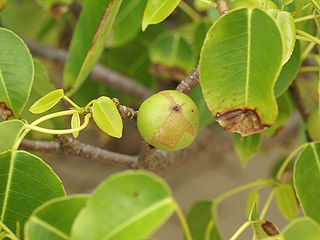
Hippomane is a genus of plants in the Euphorbiaceae described by Linnaeus in 1753. It is native to the West Indies, Central America, Mexico, Florida, Venezuela, Colombia, and Galápagos.
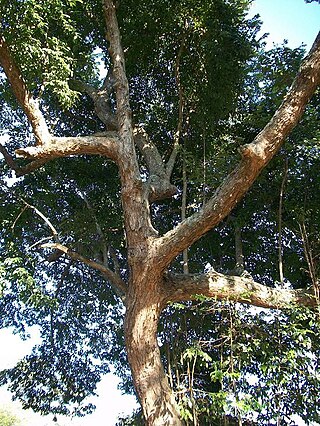
Margaritaria is a plant genus of the family Phyllanthaceae first published as a genus in 1782. It is the smallest pantropical genus of the Phyllanthaceae and, formerly, of the Euphorbiaceae, widely distributed in tropical and subtropical regions of Asia, Africa, Australia, North and South America, and various oceanic islands.

Securinega is a genus of plants in the family Phyllanthaceae, first described as a genus in 1789. As presently conceived, the genus is native to Madagascar and the Mascarene Islands in the Indian Ocean. In the past, it was considered to be much more widespread, thus explaining the long list of species formerly included. It is dioecious, with male and female flowers on separate plants.
- Securinega antsingyensisLeandri - W Madagascar
- Securinega capuroniiLeandri - W Madagascar
- Securinega durissimaJ.F.Gmel. - Madagascar, Mauritius, Réunion, Rodrigues Island
- Securinega perrieriLeandri - W Madagascar
- Securinega seyrigiiLeandri - W Madagascar
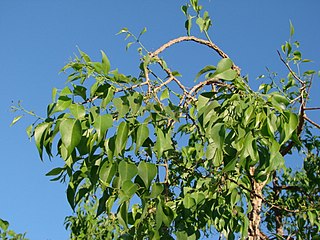
Agonandra is a genus of plants in the family Opiliaceae described as a genus in 1862.

Plinia is a genus of flowering plants in the myrtle family, Myrtaceae described by Linnaeus in 1753. It is native to Central and South America as well as the West Indies.

Dalechampia dioscoreifolia is a species of plant in the family Euphorbiaceae first described in 1841. It is native to Central America and northern and western South America.

Sievekingia is a genus of orchid, comprising 20 species found in Central and South America, from Nicaragua east to the Guianas and south to Bolivia.

Flueggea, the bushweeds, is a genus of shrubs and trees in the family Phyllanthaceae first described as a genus in 1806. It is widespread across much of Asia, Africa, and various oceanic islands, with a few species in South America and on the Iberian Peninsula.

Ludovia is a genus of plants first described as a genus in 1861. All the known species are native to Central and South America.
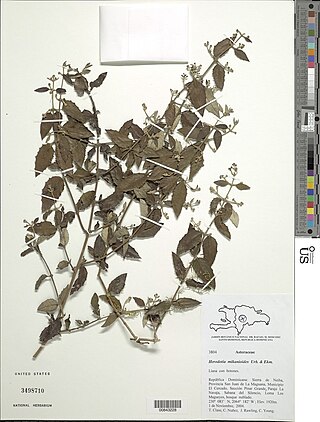
Ekmaniopappus is a genus of flowering plants in the daisy family.

















